How To Draw A Tree Leaves
How to Depict Trees
Updated: 24 Feb 2022

In this guide, I will demonstrate how I simplify the drawing process, and I hope that by the end of it y'all will be able to draw your favorite tree.
In order to describe realistic trees with pen and ink, it is important to pay attention to accurateness of the form (structure), and to acquire how to create the illusion of brightness values and transitions with pens.
Bamboo
When looking at ANY tree, examine its bones shapes.
It is a skillful practice to draw its simple shapes first:
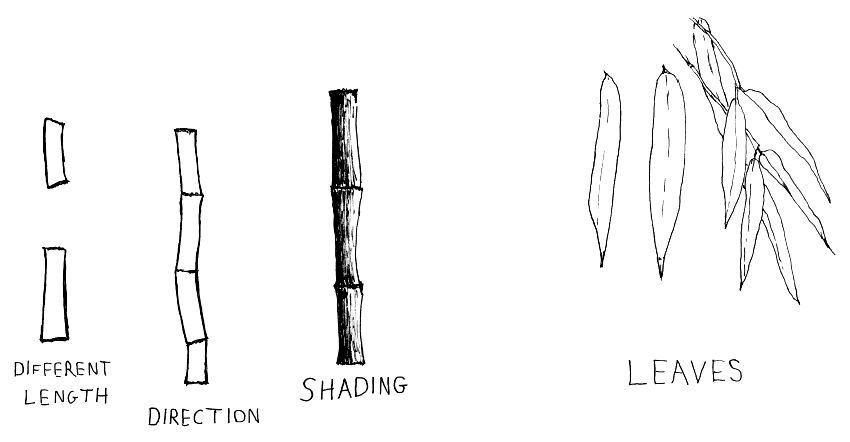
Once you understand these unproblematic shapes, you tin use your artistic license and your noesis to recreate it.
There is no point drawing every single leaf every bit y'all run into it (when using a reference image equally a guide).
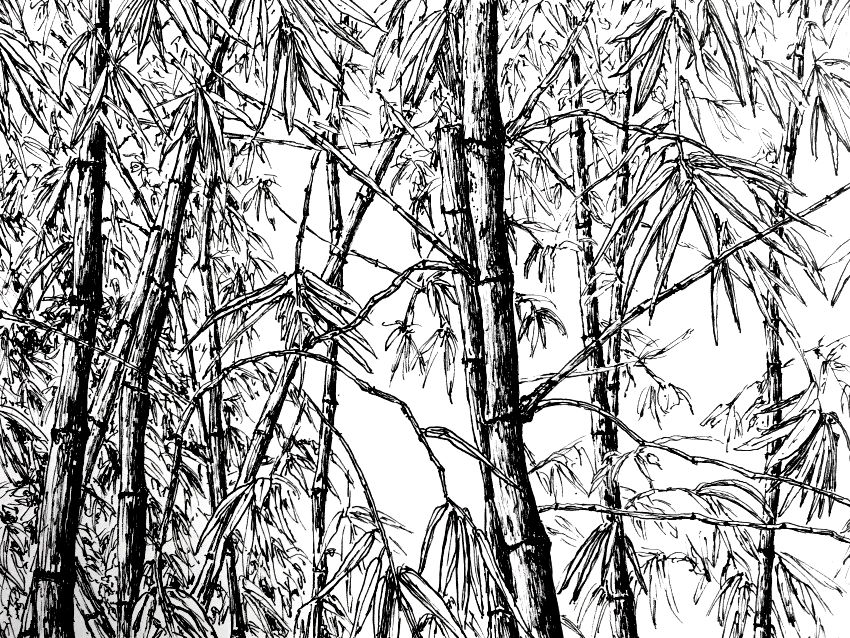 Bamboo
Bamboo
Assistant Tree
For copse with large leaves, like a banana tree, first draw a written report of the leaves from different angles.

For a realistic outcome, make sure in that location is no symmetry, and that each leafage is unique.
You can utilise markers; they work well with pens.
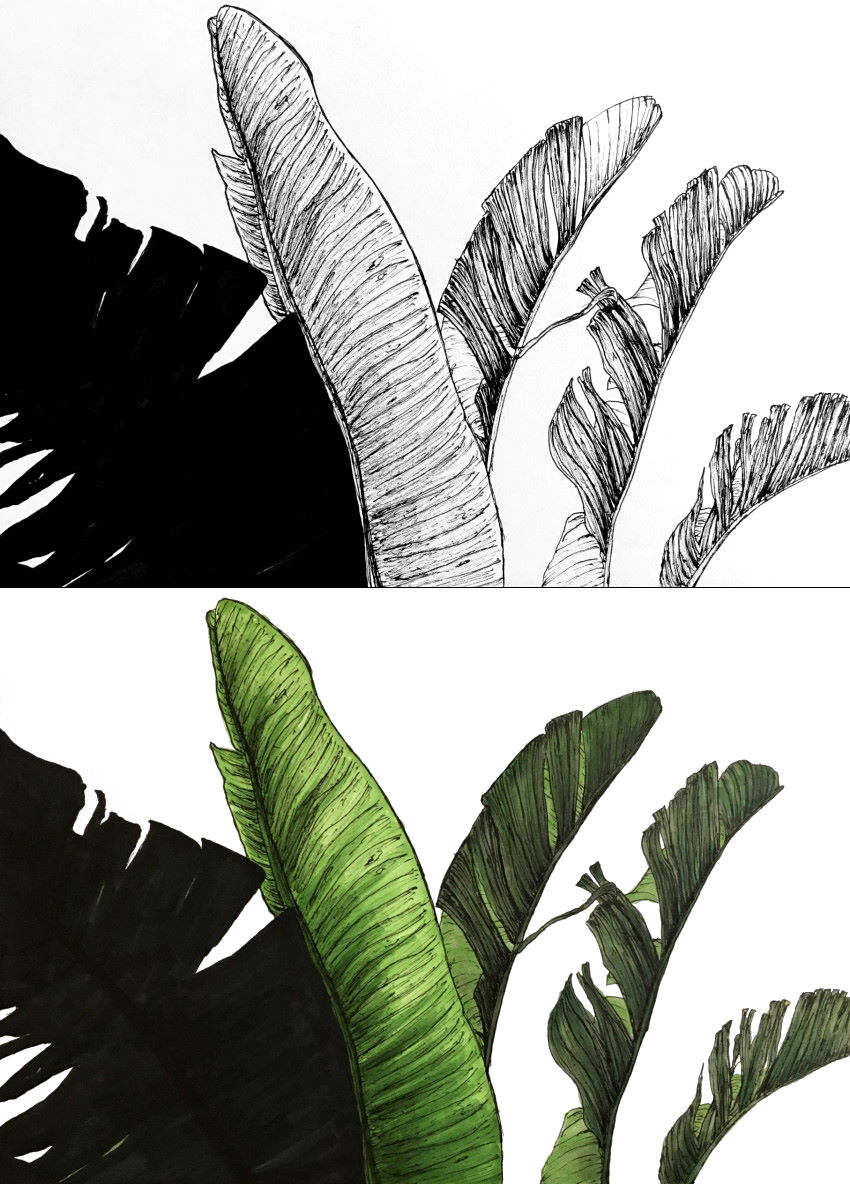
Olive Tree Trunk
Look at some reference images, or bodily trees, before cartoon the tree torso.
Get-go, draw outlines to create the form (structure).
Recollect:
Depict sparse and gentle outlines, then they are not bold.
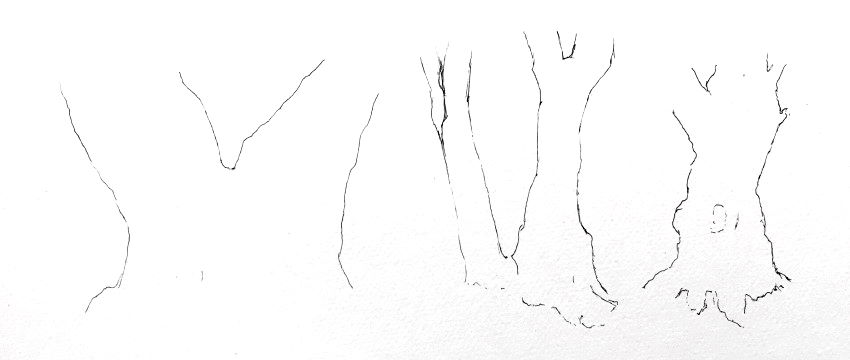
Next, add together some guidelines and bones details.
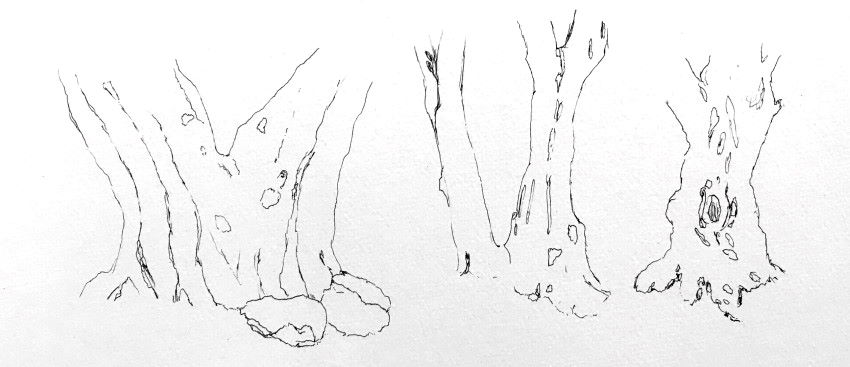
Terminal step is texture drawing.
Focus mainly on brightness values, while cartoon marks with shape and management like the reference prototype.
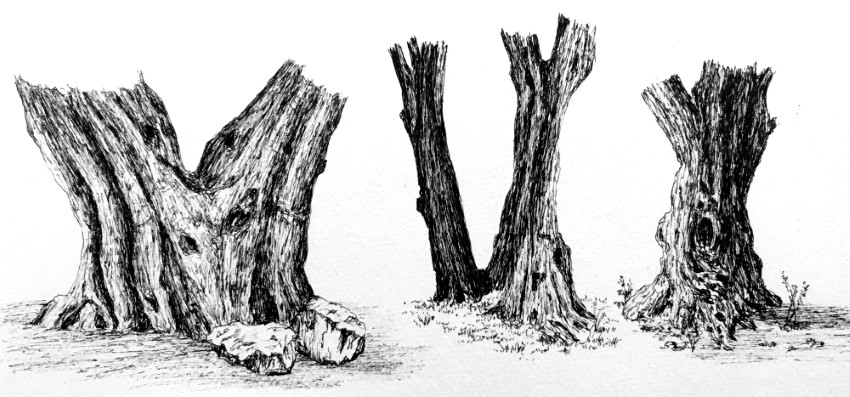 Olive tree trunks
Olive tree trunks
Keep in mind:
Each olive tree trunk has its own "personality", but all olive trees share common basic shapes.
How to Draw Leaves
Cartoon leaves tin can be challenging. Understanding their construction, and breaking the drawing process into steps, will produce a satisfying and realistic outcome.
Each tree leaf is in different direction, has a different degree of foreshortening, and is overlapping other leaves.
Simply put, the grade and texture of leaves is abstract and messy.
To describe that, you need to be sketchy and loose with your marks, and to avoid whatsoever pattern!
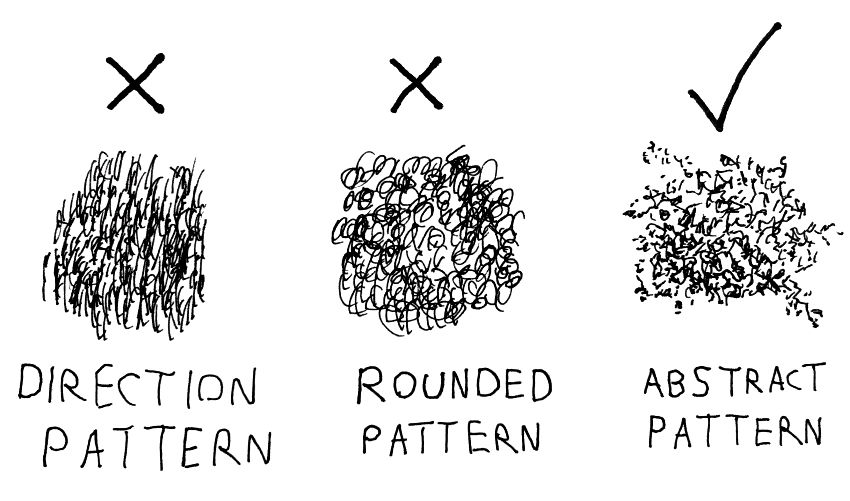
Side by side step is to pay attention to effulgence values. That is how you create the illusion of volume. Meaning, three-dimensional and non flat.
To create that illusion, scribble more than lines for darker values, and fewer lines for brighter values:
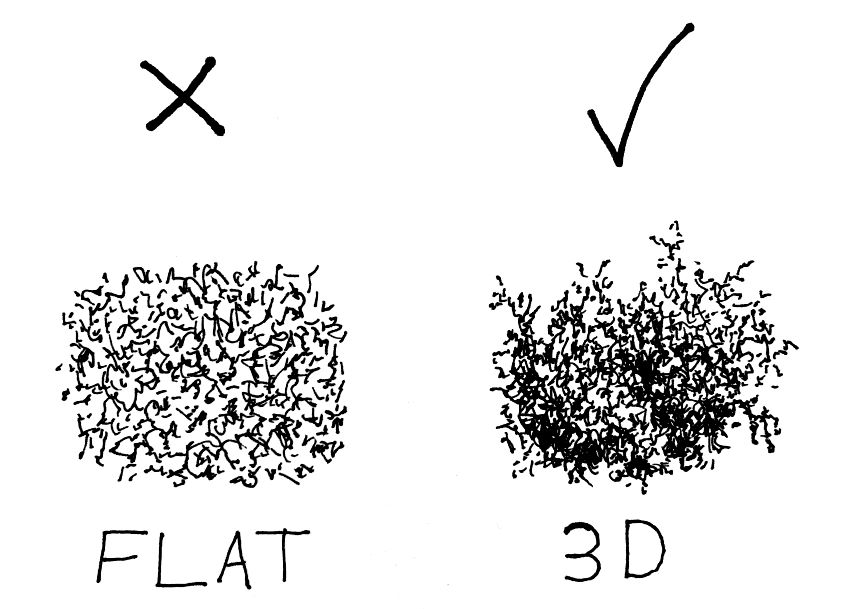
In addition, pay attending to leaves size, depending on the tree blazon, and how distant it is from the observer.
For large leaves, sketch large marks, and vice versa:
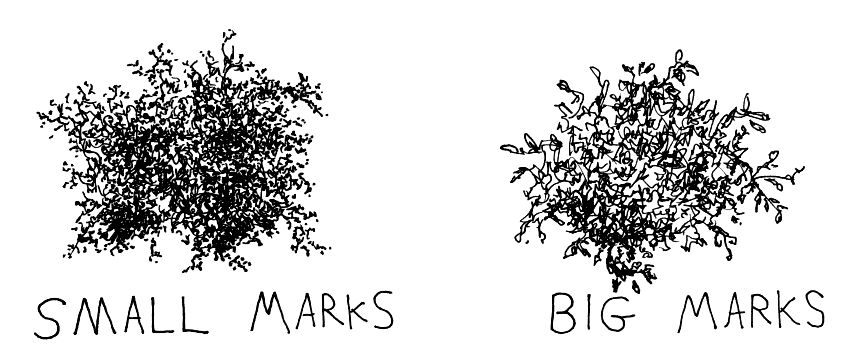
While the treetop is messy, at its edges you can add some indication of leaves type and size.
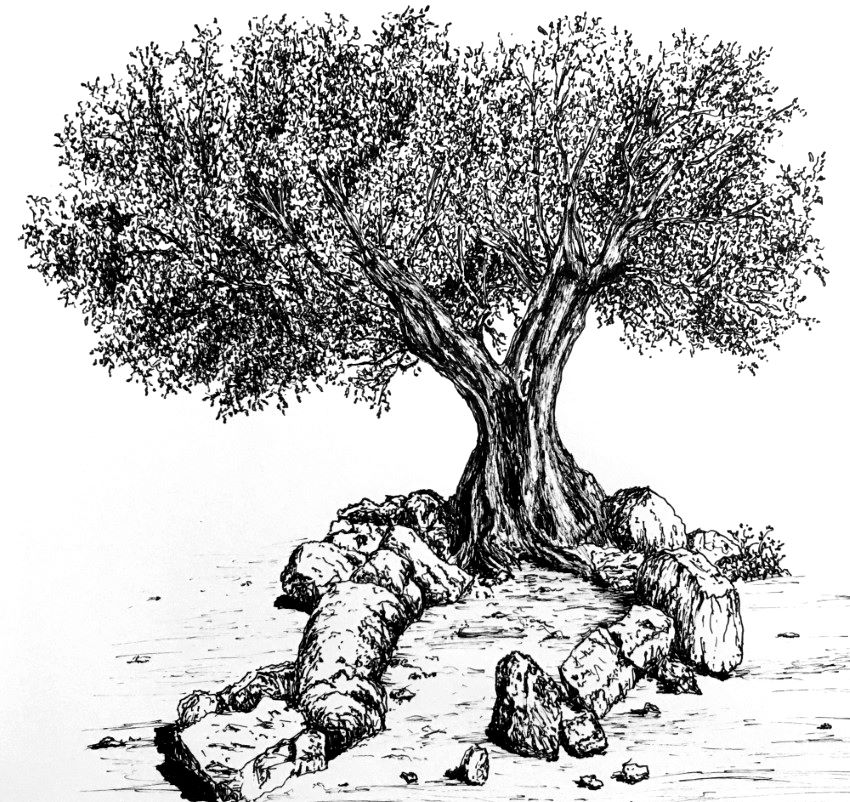 Olive tree
Olive tree
Later agreement the characteristics of a specific tree (olive tree in this instance), it is quite easy to describe it from imagination.
If some terms like foreshortening and overlapping are new to you, read my guide on how to draw with a sense of depth. Information technology covers xv methods to add depth to your drawing or painting.
Good to know:
By and large, I use a pen with nib size 0.1. It is modest plenty to create fine details.
Photos & Contrast
When I am taking photos of a tree, I do it from several angles.
If possible, I circle the tree to become a photo from every angle.
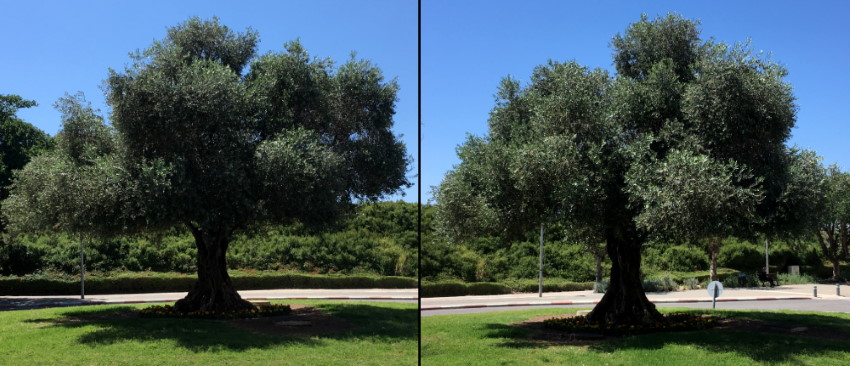
I select a photo that has high dissimilarity as my reference image.
Contrast betwixt highlights and shadows is crucial for a drawing to stand out, and to take presence.
Not enough contrast leads to a flat drawing with no depth. Too much contrast looks cartoonish.
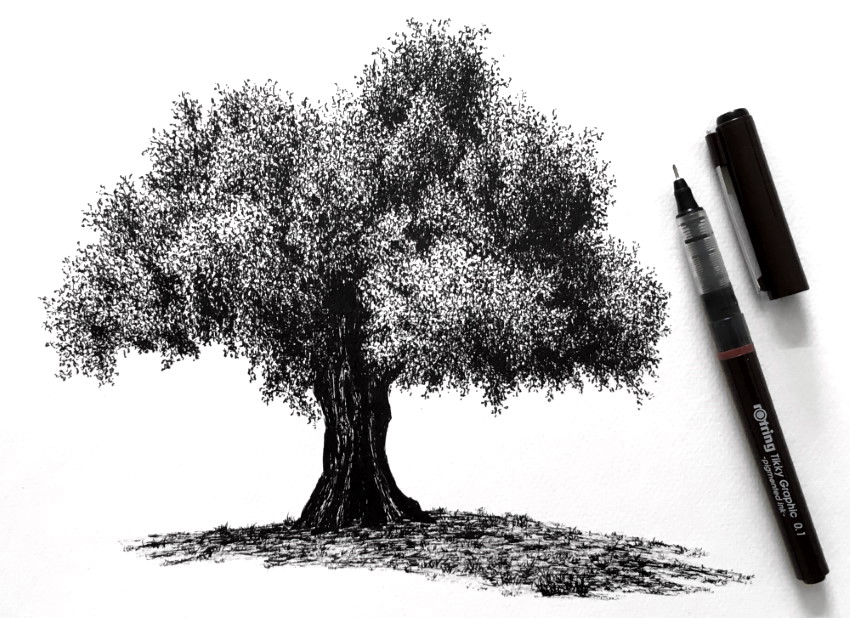 Olive tree
Olive tree
Pine Trees
Important:
Before diving into complex texturing and rendering, if you are a beginner, y'all might want to practise the next pace.
Describe any random tree shape, sketch some random marks to fill it up, and and so draw more sketchy marks in one side and at the bottom of the tree (to create a darker value for the shadow expanse).
This should not take more 5 minutes! The advanced texture you will come across after this instance is only a matter of many hours of do to refine the texture marks.

Pine trees are relatively easy to describe from imagination.
They have very small, needle-similar leaves.
I like to start by gently cartoon the class, and then make full information technology with pocket-size, random marks, that are Not in any specific direction or with reoccurring shape.
Last pace is to draw more than marks for darker areas, depending on the direction of calorie-free yous choose.

Pine trees come up in many types and shapes.
Looking at a reference epitome can help at the first, just as a guide to depict the form, and to pay attention to dark and lite areas.
Other than that, attempt to be loose and sketchy with your marks.
When drawing a close-up view, you can bespeak the needle-like leaves at the edges of the tree.
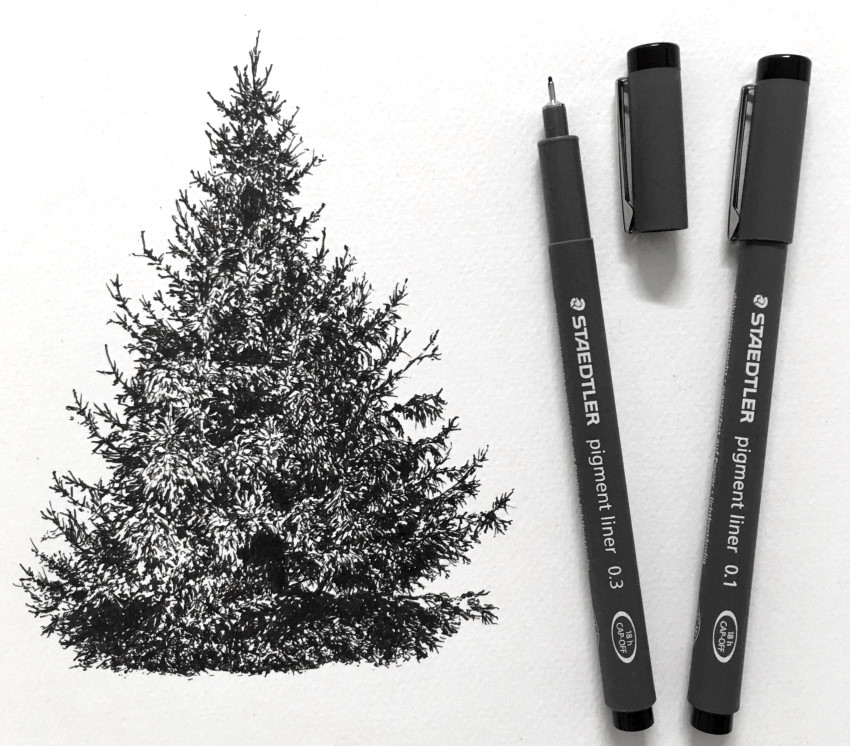 Pine tree
Pine tree
Snowy Pine Tree
A pen has merely one brightness value. Therefore, you accept to utilise different techniques to create the illusion of transitions in brightness values.
One technique (or style) is to use hatching. Hatching means drawing parallel lines.
By drawing lines with unlike degree of spacing between them (or with different line width), you lot can create an illusion of unlike effulgence values.
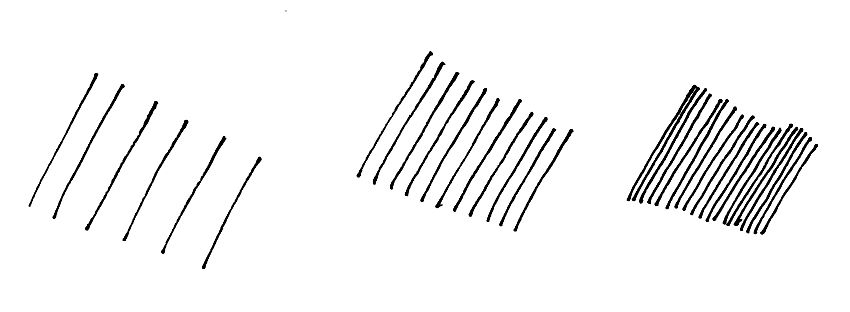
Another method is to use cross-hatching.
Cantankerous-hatching means drawing sets of parallel lines in different direction. Past adding more sets of cross-hatching, you can create the illusion of darker values.

You tin utilize Whatsoever pen for drawing. I prefer artist-grade technical pens (also fineliners). They create lines with fixed width, and their ink is made of pigments, which is very durable and lightfast.
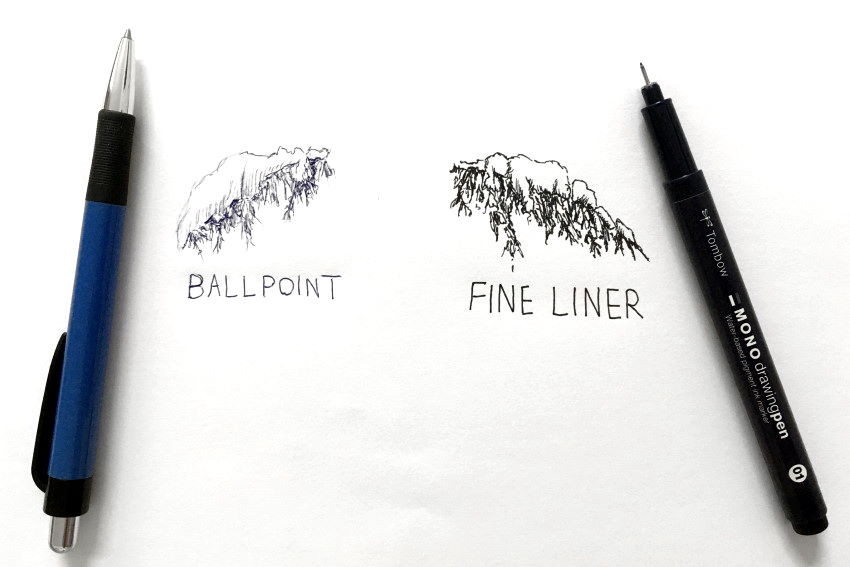
For the snowfall part, you can exit it empty ("white"), or you lot can use hatching in some areas.
In this example, I used some hatching, and some marks with very light gray marking.
 Snowy Pino tree
Snowy Pino tree
If you desire to know more about markers, visit my markers review for artists.
Christmas Tree
A Christmas tree is just another pino tree, but with decorations.
To add some baubles, first draw their shape, and then attempt different types of hatching, cross-hatching, and stippling.
Stippling is a drawing technique that uses dots. The more dots y'all add together in 1 surface area, the darker it looks.
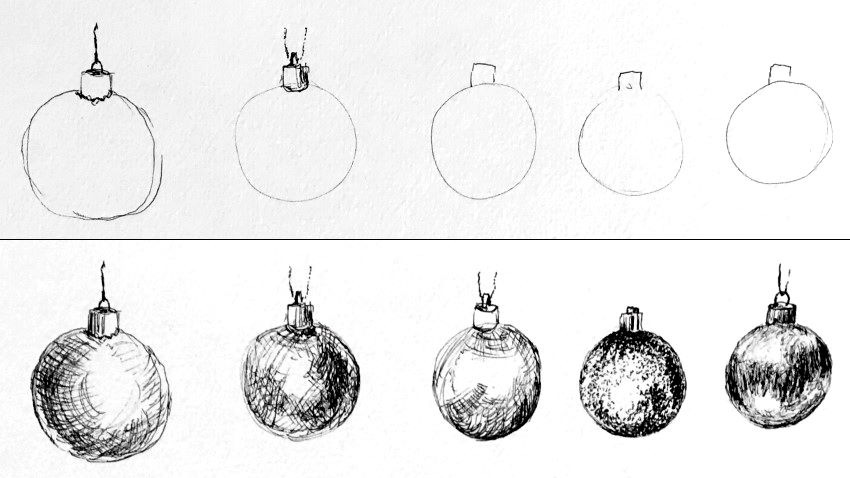
You can add other decorations to your Christmas tree.
Information technology is best to first sketch some examination drawings on a unlike newspaper, to see what works, before adding them to your cartoon.
To add boxes in perspective, you should be familiar with linear perspective drawing, and learn to draw from imagination.

Tip:
If you notice it difficult to depict a tree with a pen, y'all tin always start with a pencil.
When y'all reach a satisfying consequence, you can go over it with a pen, and gently erase the pencil marks.
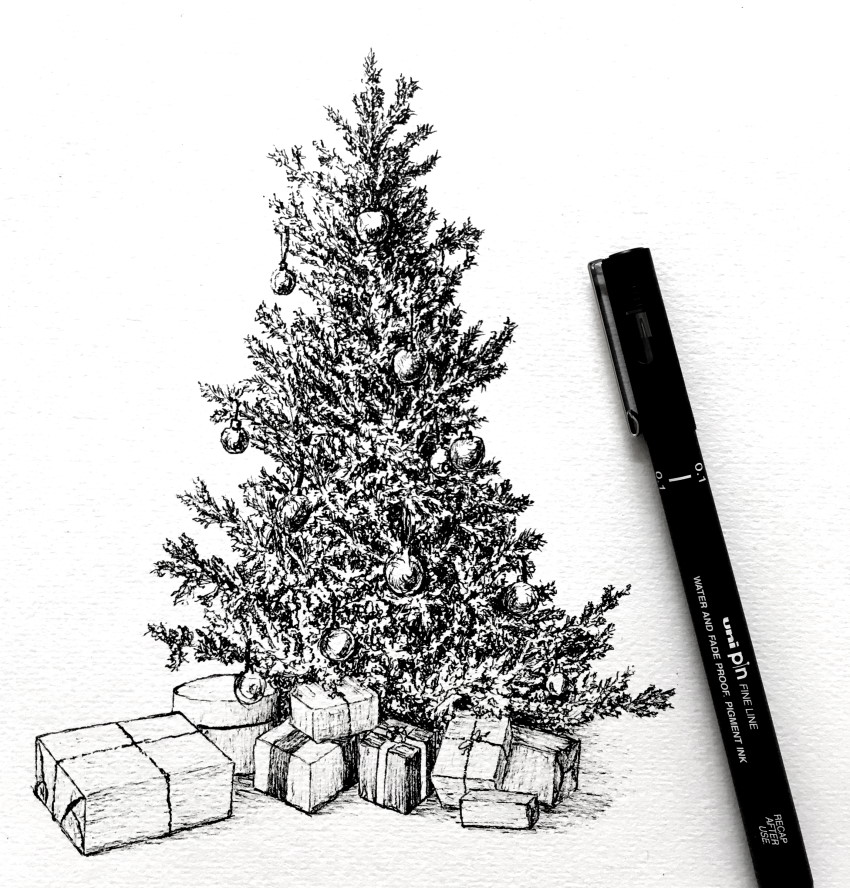 Christmas tree
Christmas tree
Cartoon with White Pens
When drawing with white pens, pay attention to the same drawing fundamentals.
While with black pens you describe more lines for darker areas, with white pens you should draw more lines for lite/bright areas.
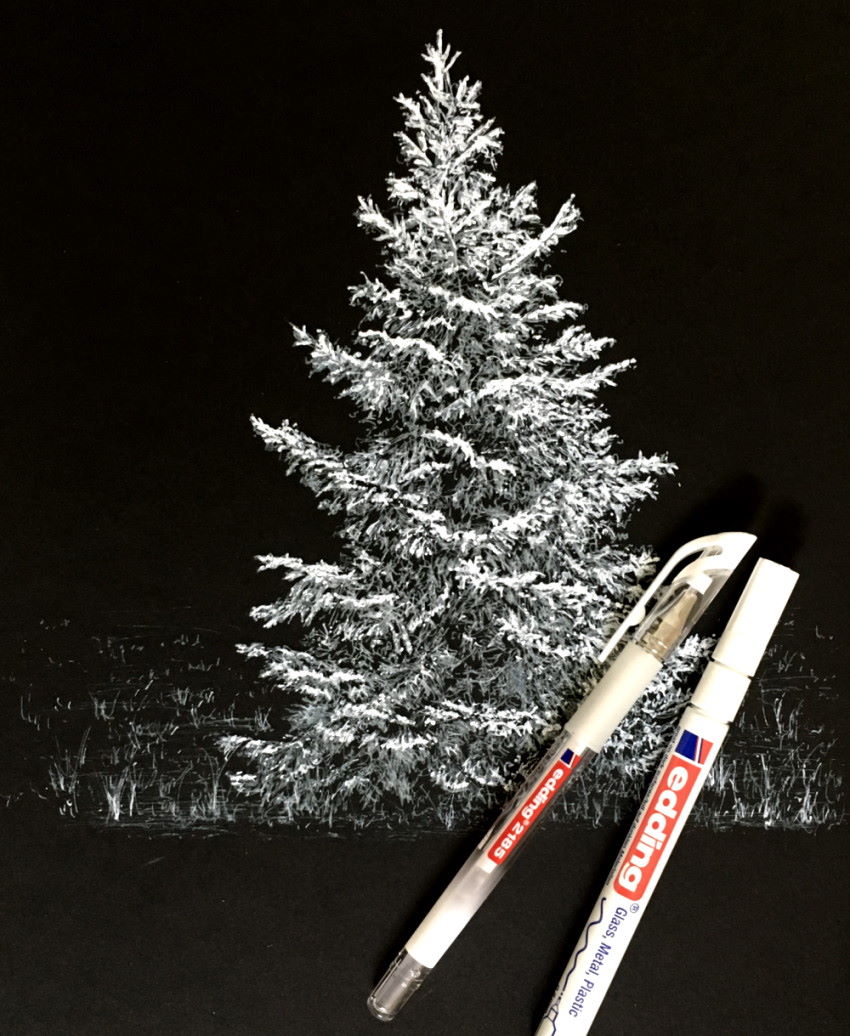
These pens are nearly effective on black (or dark) newspaper, and for highlights.
Keep in mind:
White pens are designed for covering.
Drawing with a black pen (which has ink) over white areas (made by a white pen), may ruin the pen's beak, considering it volition exist covered with the white substance (therefore its ink will not period smoothly).
Aspen & Birch Trees
Aspen & birch tree trunks are easy to draw when doing it in steps.
Draw the form first:
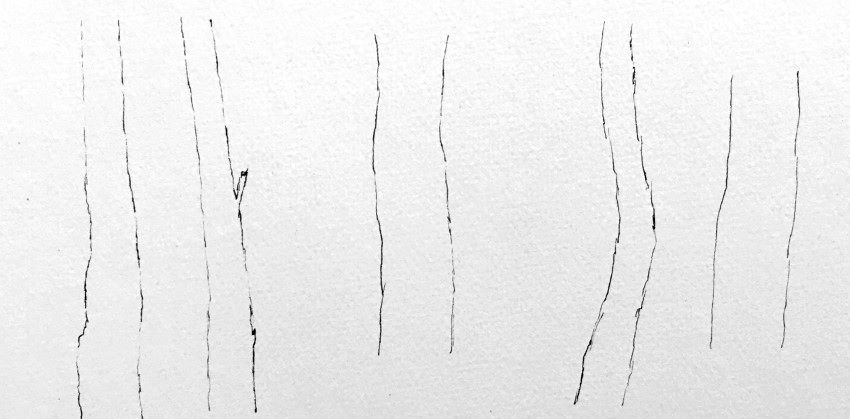
And so, add together some bones details:
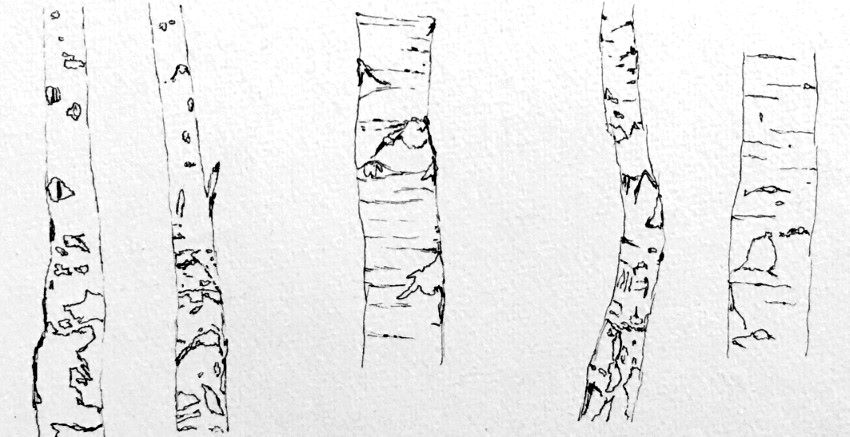
Finally, describe some brightness values, and texture:
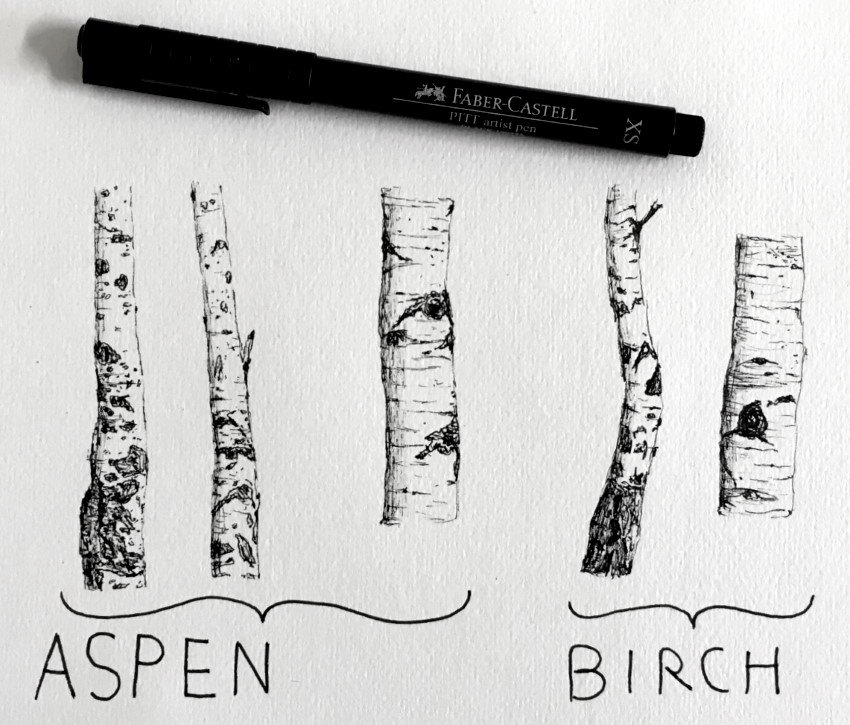 Birch & aspen tree trunks
Birch & aspen tree trunks
Y'all can use (light) grayness markers for coloring:

Overlapping
Overlapping means an object that partially covers another object.
When you see an object that overlaps another object, you lot assume that this object is in front of the object it covers.
Overlapping is one of the most powerful ways to create the illusion of depth on a flat paper.
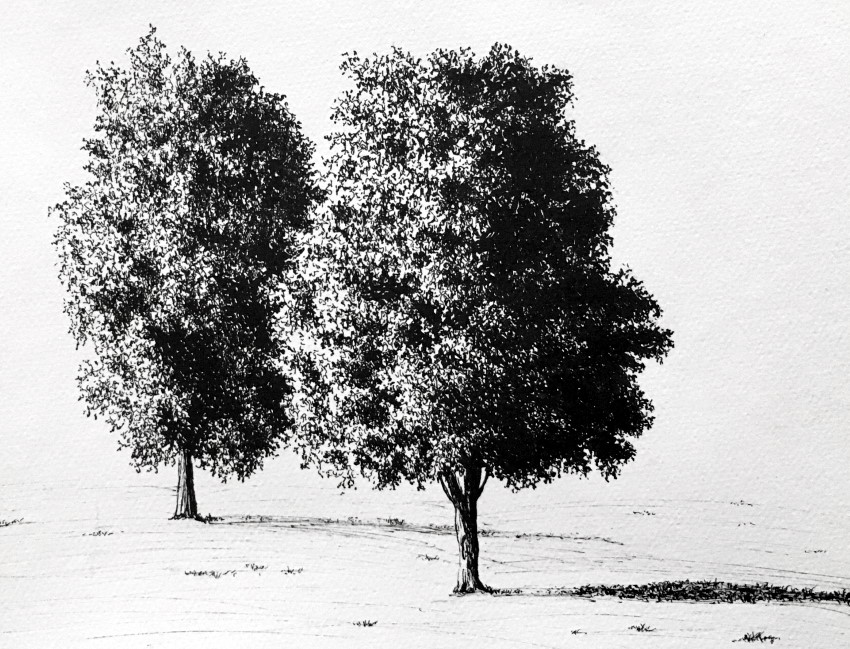 Overlapping trees
Overlapping trees
Because you cannot erase pen marks, it is all-time to draw foreground objects first!
If y'all want to draw a house in front of a tree, draw the business firm first:

Do the aforementioned for tree branches.
Starting time, draw the branch that overlaps a tree, and so the tree body.
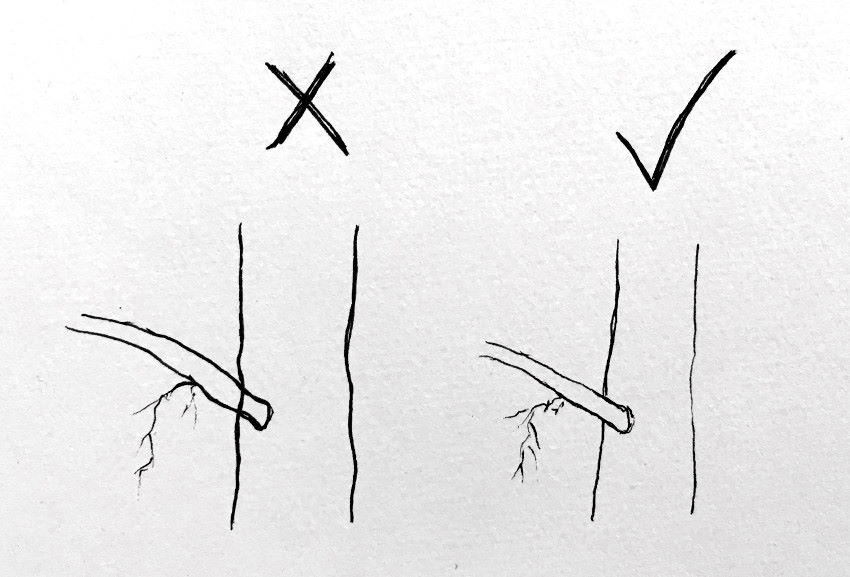
For trees that take a complex structure, with many branches, you can apply a pencil to draw the basic shapes.
When you are happy with the result, you can depict over it with a pen, and gently erase the pencil marks.
 Birch trees
Birch trees
Transitions
Transitions are office of drawing (and painting) fundamentals. They be everywhere!
For example, dissimilar areas of a flat aeroplane have different relationships with whatever light source, reflections, and shadows.
Therefore, always look for transitions (in brightness values) for your cartoon to look realistic and natural.
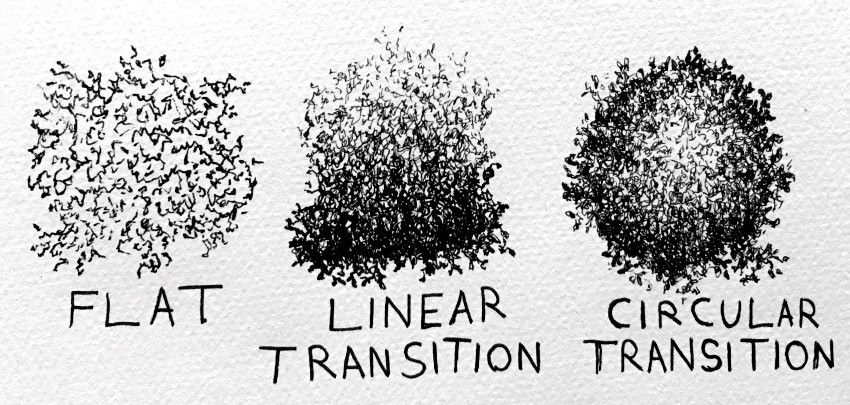
Kickoff, await for lite and dark areas.
Then, look for transitions within each area. Transitions from dark to low-cal, from lite to lighter, and from dark to darker.
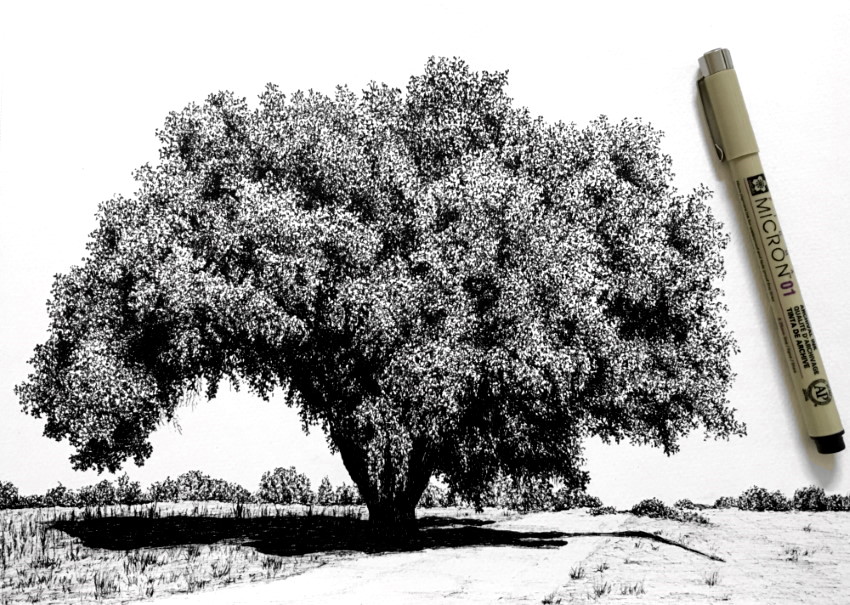 Oak tree
Oak tree
Past cartoon with NO transitions (and using hard edges), you lot tin can create something that looks unnatural, as opposed to something realistic with transitions.
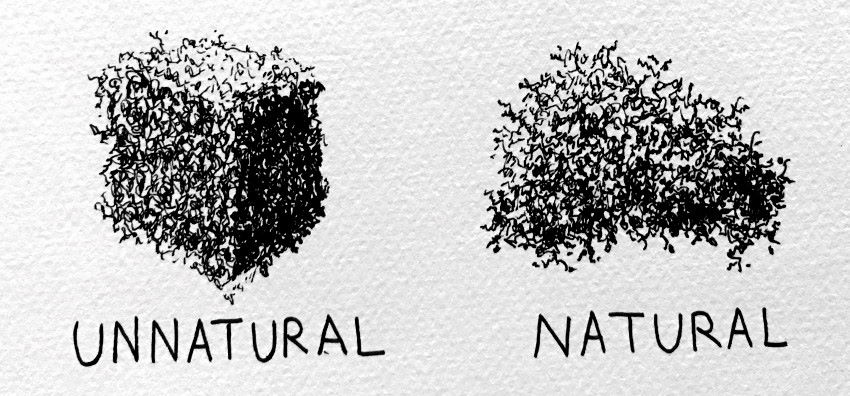
The aforementioned way a gardener trims bushes and trees, you can use your artistic license to create something that looks artificial or human-made:
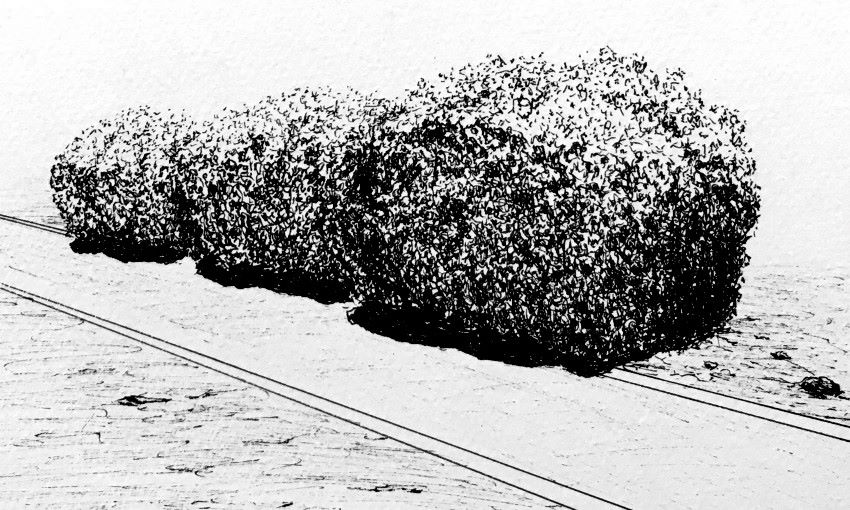
Artistic license ways to apply your knowledge and feel.
Once yous sympathise how to draw leaves, you can draw anything with leaves texture. Objects, figures, vehicles, or even a refrigerator:
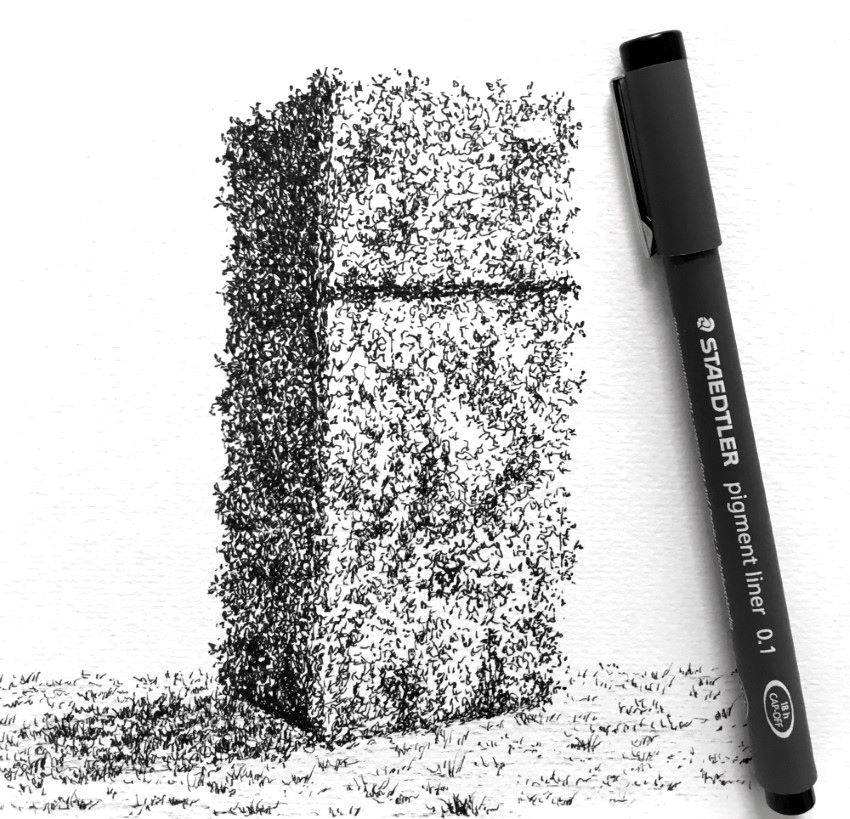
Skilful to know:
Transitions are not limited to brightness values. Transitions exist in colors, texture, edges, and temperature (transition from warm colors to cool colors).
If yous are struggling with realistic drawing, you might desire to read my realistic pencil-drawing guide. It covers the 4 important fundamentals (accuracy of the form, brightness values, edges, and transitions).
Weeping Willow
A weeping willow tree is a flake catchy to draw.
Its leaves are easy to draw at an up-shut await. As you get further abroad, you tin can see long clusters of leaves with no unmarried leaf shape.
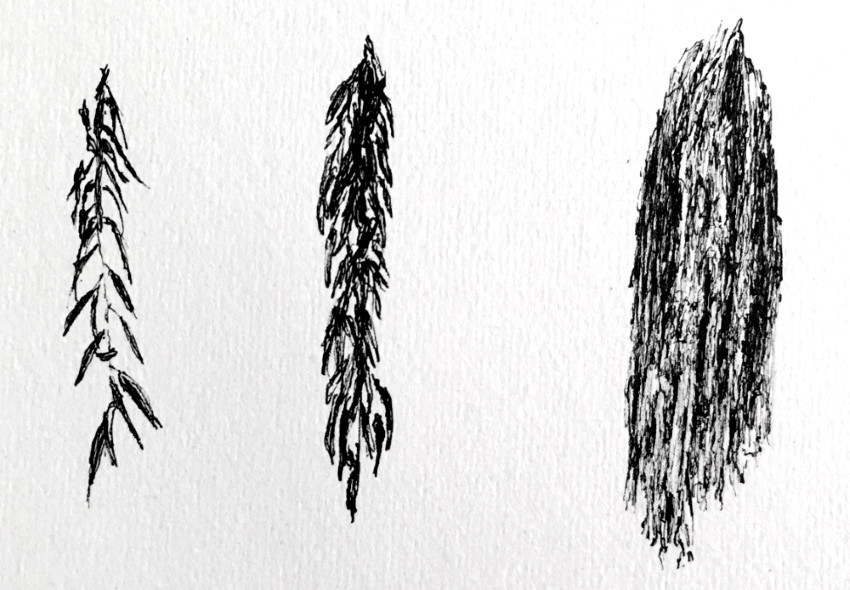
Yous tin can outset past drawing an outline for the tree structure. Practise it gently.
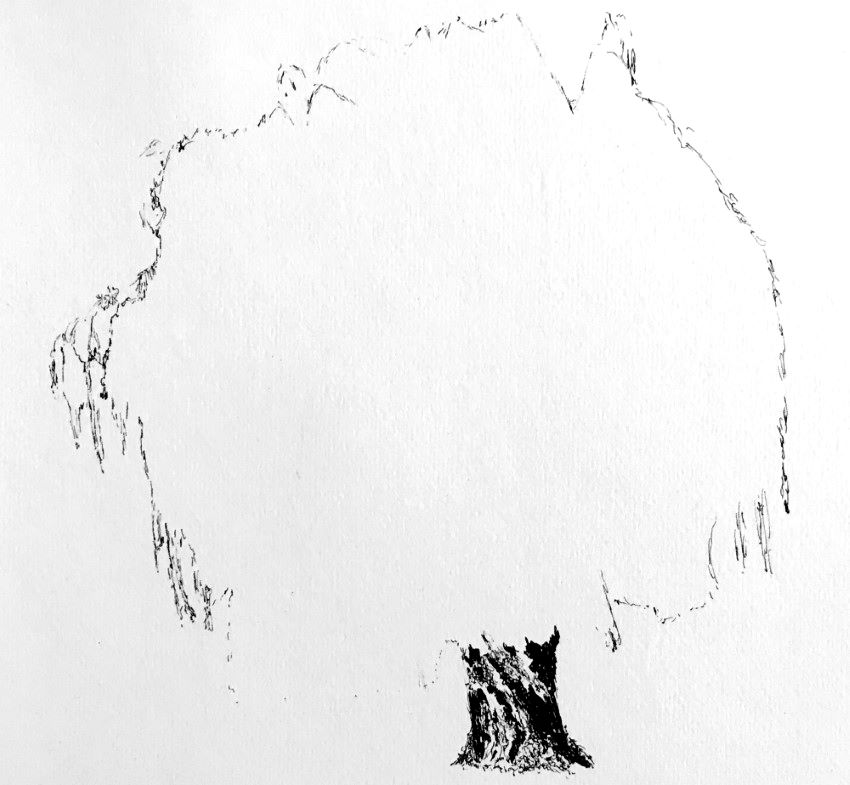
Then, ane way is to draw the treetop (crown), section by section.
Alternatively, like in this case, you can describe the dark values start.
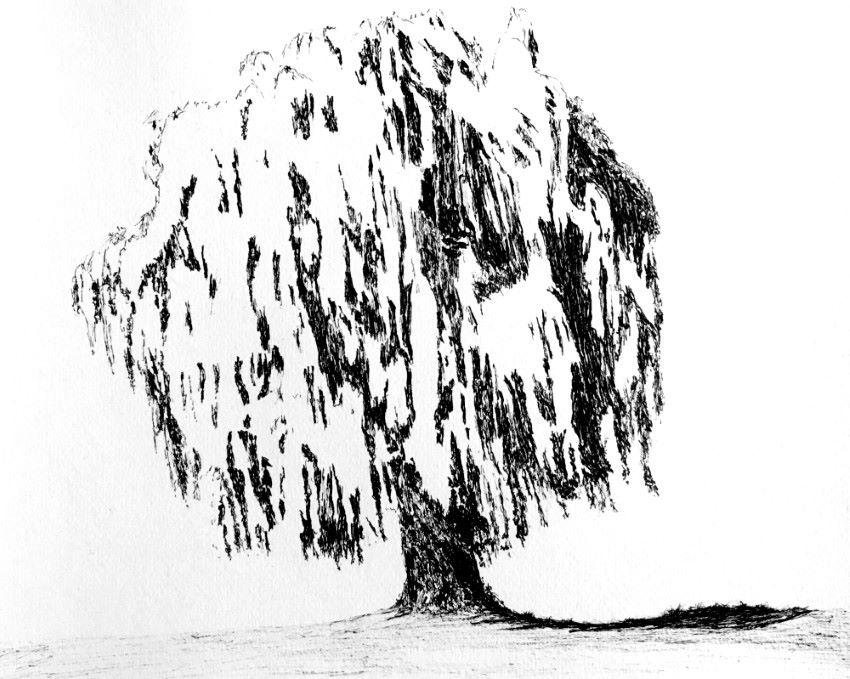
Something to consider:
Every bit mentioned above, a pen has one effulgence value (usually black, though other colors exist, more on that later).
Past drawing gently and swiftly, with a sharp angle, you tin can produce lines that are less defined, and therefore with a lighter value.
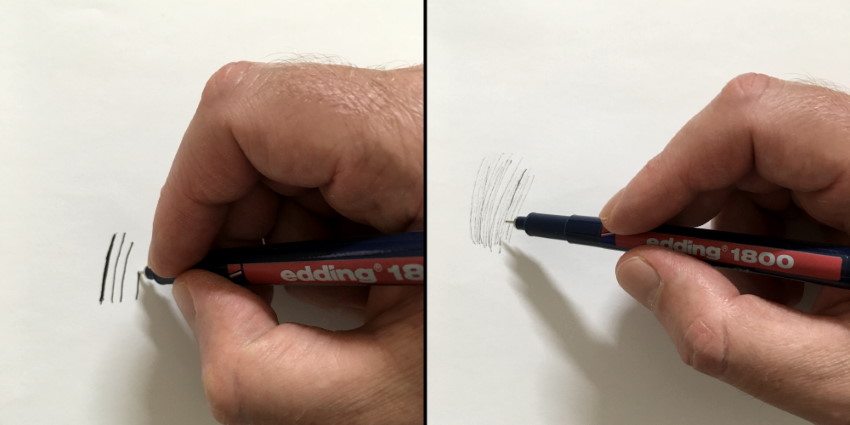
The final pace is to add the light values.
Pay attention to effulgence values, transitions, and texture. Be abstract with your marks, nevertheless with a sense of direction.
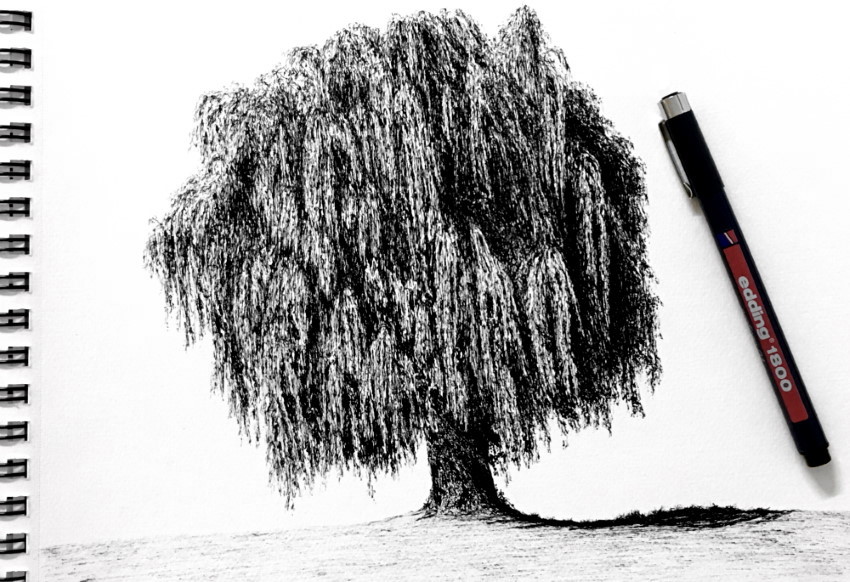 Weeping Willow
Weeping Willow
How to Draw Huge Trees
For some large trees, like Ficus, I like to use a large paper sail (A3 in this case).
If the tree is too complex to draw, you can draw a filigree (softly with a pencil), to dissever the paper into smaller sections (and use the same grid for your reference image).
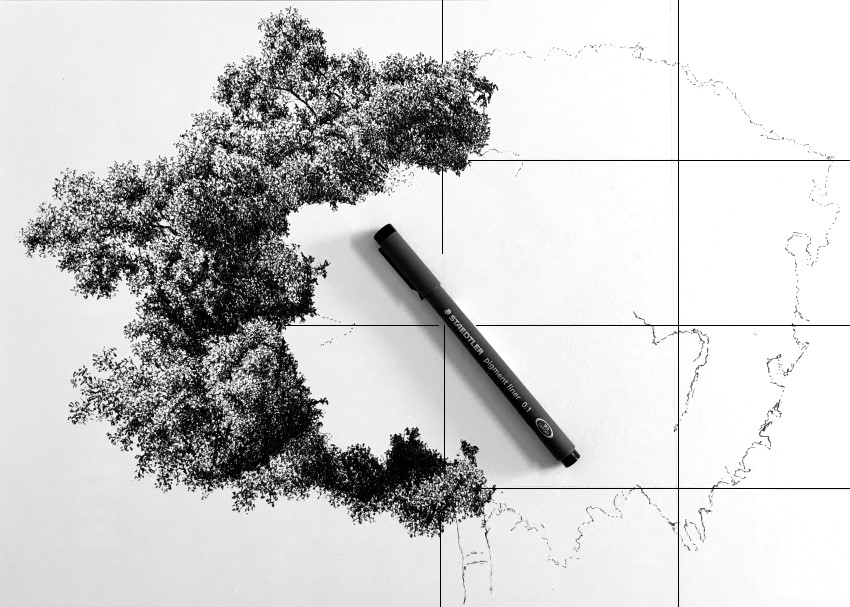
Go along in mind:
Cartoon on a large paper with a pen (or a pencil) is time-consuming. For a tree similar this, it can hands take more 20 hours to complete.
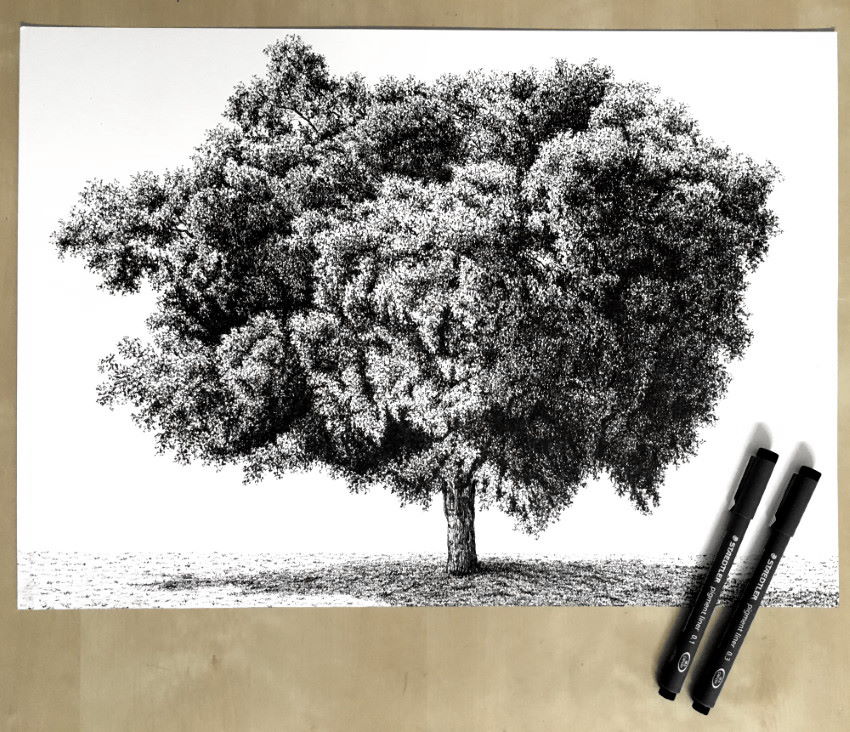 Ficus tree
Ficus tree
Sometimes, huge drawings may not look then big on a small screen.
Y'all can give information technology context by calculation groundwork trees (from imagination in this example).
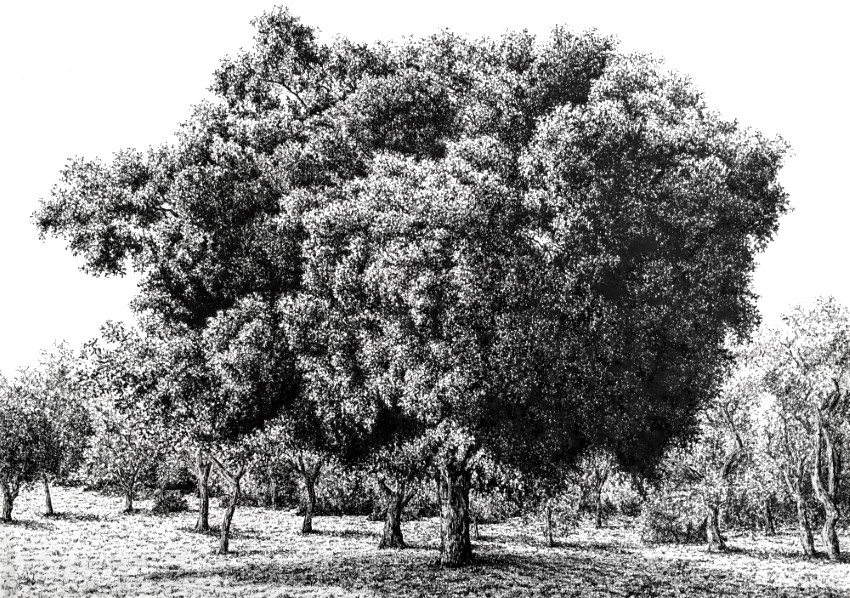 Groundwork drawing
Groundwork drawing
Something to consider:
You should use the rules of atmospheric perspective when drawing backgrounds (landscape).
When objects are far abroad, there are more atmosphere particles (that besprinkle low-cal) between them and the observer.
For far abroad objects, use less dissimilarity and fewer details. In add-on, background layers become lighter, and take soft edges.
Adding Groundwork
Trees are beautiful on their own. Sometimes though, you may want to add a background.
Drawing grass is a simple and piece of cake solution for groundwork.
Start by drawing some short lines. The lines in the front end should be a scrap bolder and longer.

Add more lines; some can be longer (mostly in the foreground).
Avoid whatever pattern, and try to be abstruse with your marks.

With a tree (eucalyptus in this case), grass (as background) adds depth.
In that location is no actual depth in a drawing, your newspaper sheet is apartment. The higher you depict on your paper (until the horizon), the farther away information technology looks.
By drawing bandage shadow by the tree, you tin add a sense of infinite to your cartoon.
To describe cast shadow, add more marks (lines) for that area, to create the illusion of dark value.
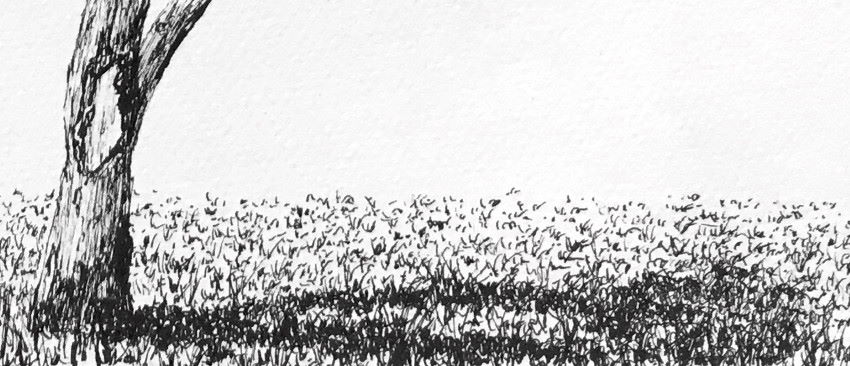
Calculation Plants
Another option is to add some plants. For case, cattail establish (Typha).
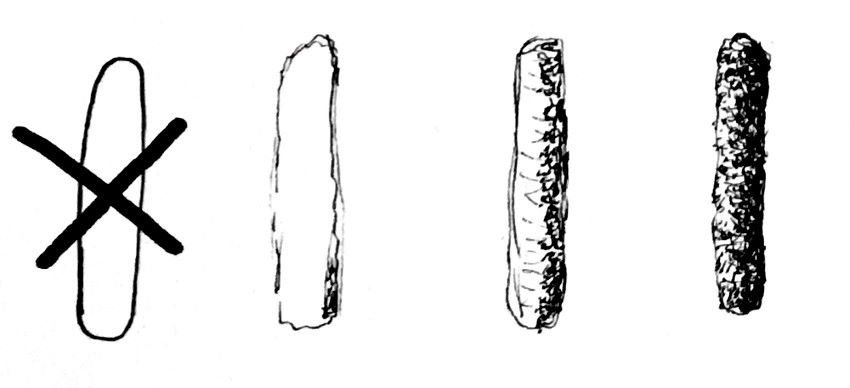
Remember:
Natural plants and trees have an abstruse shape. Make sure you lot exercise not draw them too round and compatible.
When cartoon long leaves, pay attention to cast shadows:
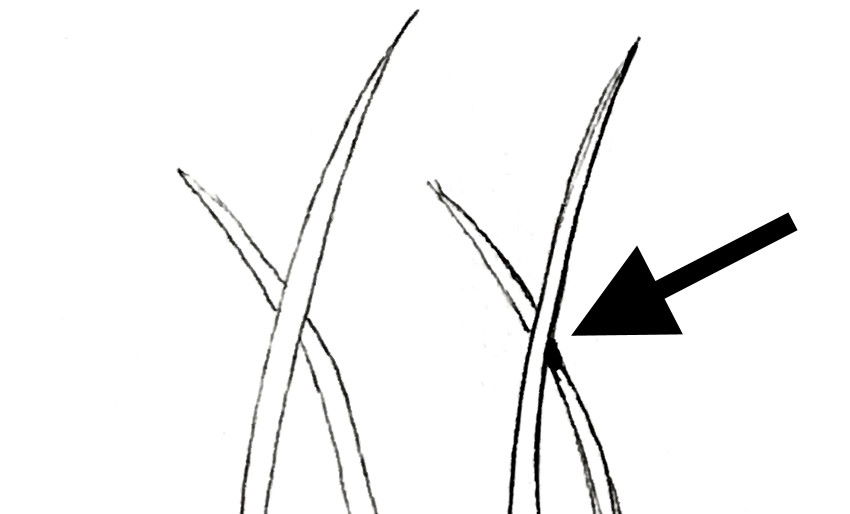
Later exam-cartoon the plant's parts, draw some loose outlines.
For realistic results, draw each bloom or leaf with unlike size, shape, and management (but, keep in mind the tree or plant characteristics).
Additionally, pay attention to overlapping.
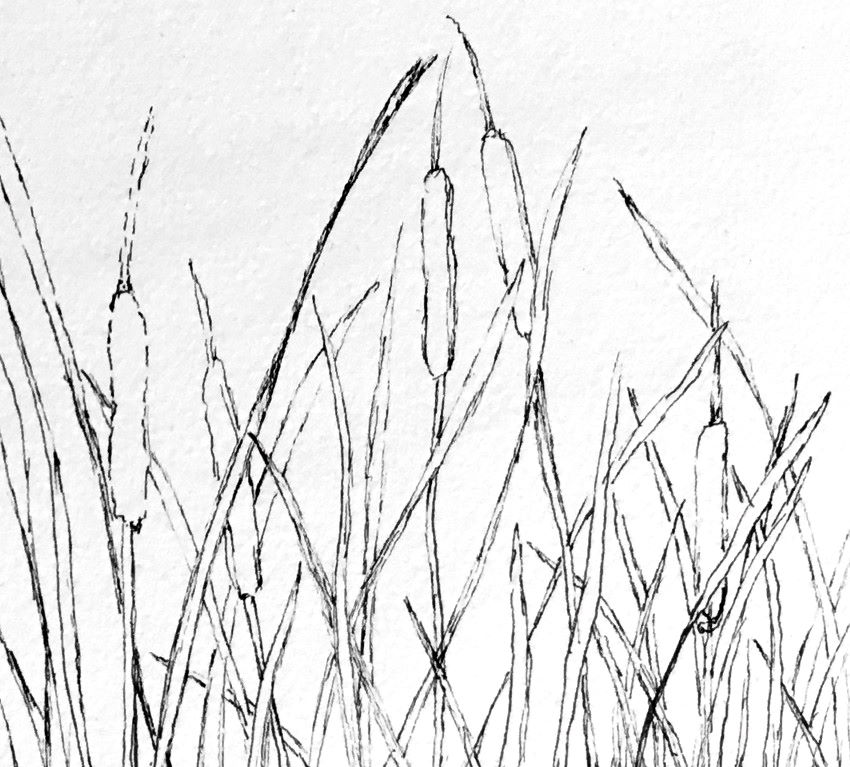
And so, add some brightness values and cast shadows.
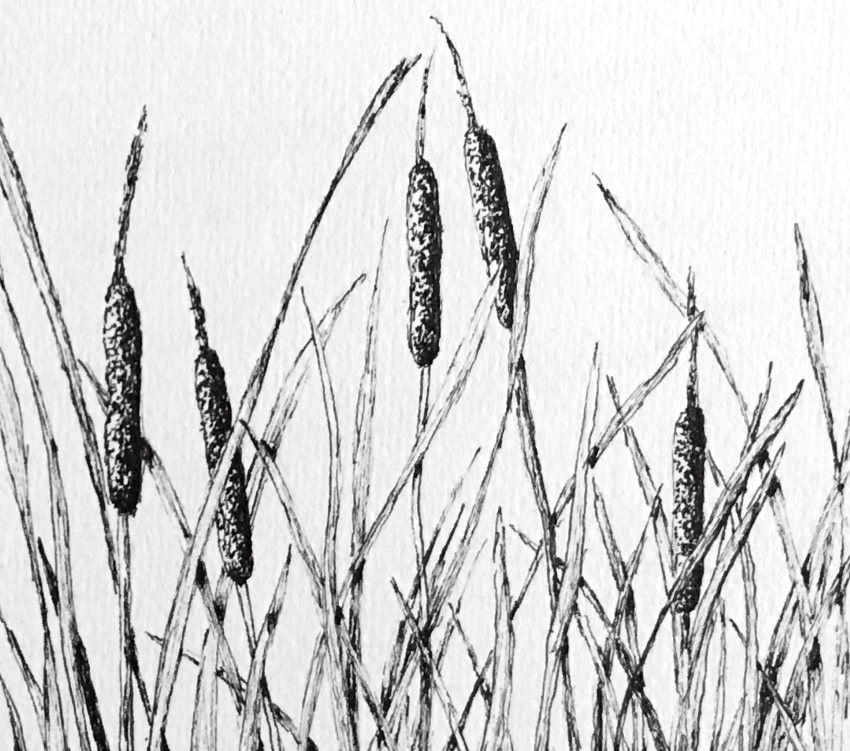 Cattail
Cattail
Now you can combine grass and plants to describe a landscape.
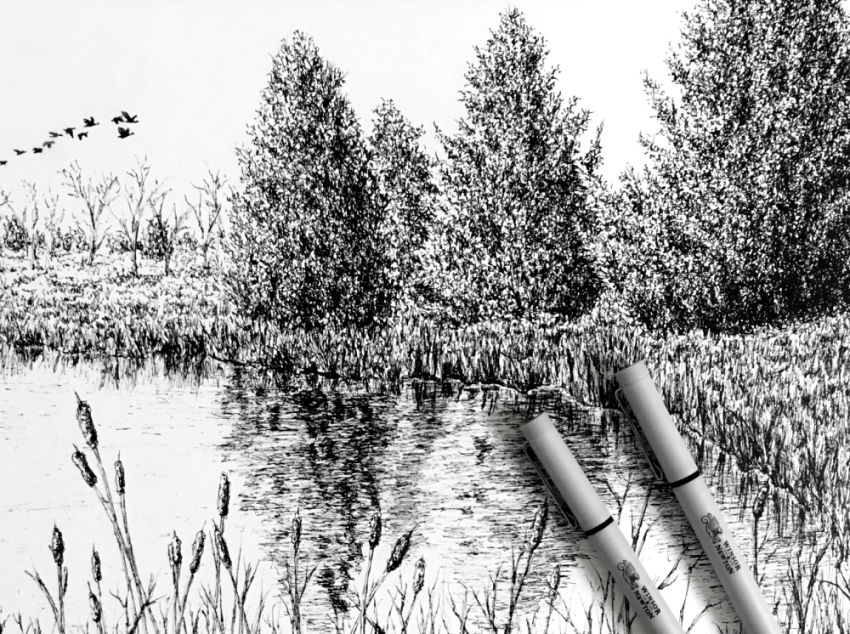 Landscape pen drawing
Landscape pen drawing
And, paint it with markers.
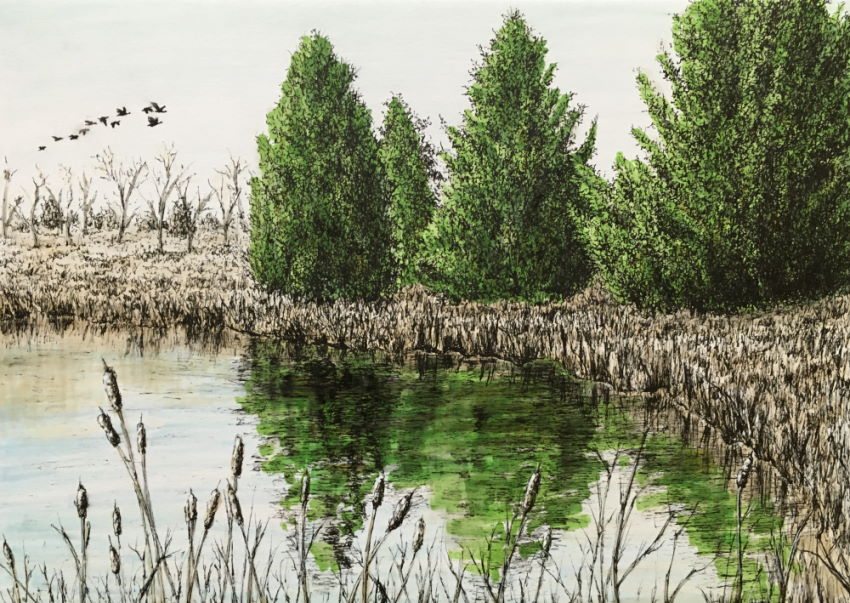 Coloring with markers
Coloring with markers
Size & Context
The way to define the size of objects is past placing them about other familiar objects.
Although a worm is usually quite small, past cartoon information technology big compared to known objects like copse, it is possible to create a giant monstrous worm.
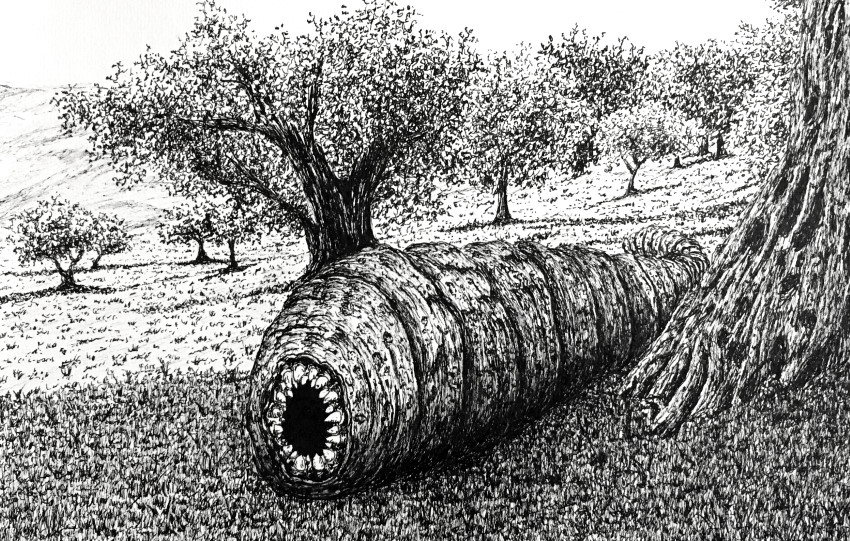 Behemothic worm
Behemothic worm
On the other hand, you might desire to describe a modest tree, similar a bonsai tree.
In this case, you demand context.
Drawing a tree in a plant pot tin assistance, but sometimes even big trees are sold inside pots.
Drawing familiar surroundings, like a room, can assistance a lot in defining the bonsai's size.
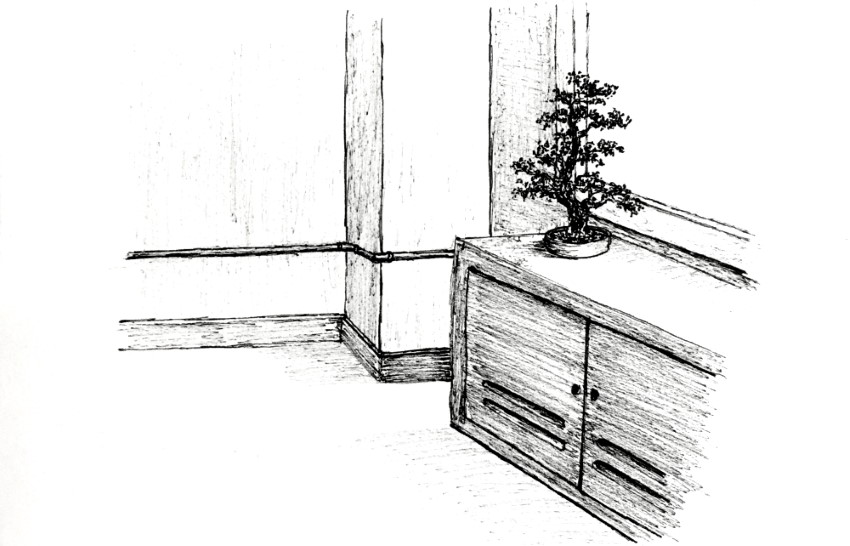 Bonsai tree
Bonsai tree
Colored Pens
While the master color for technical pens is blackness, many brands offer other color options.
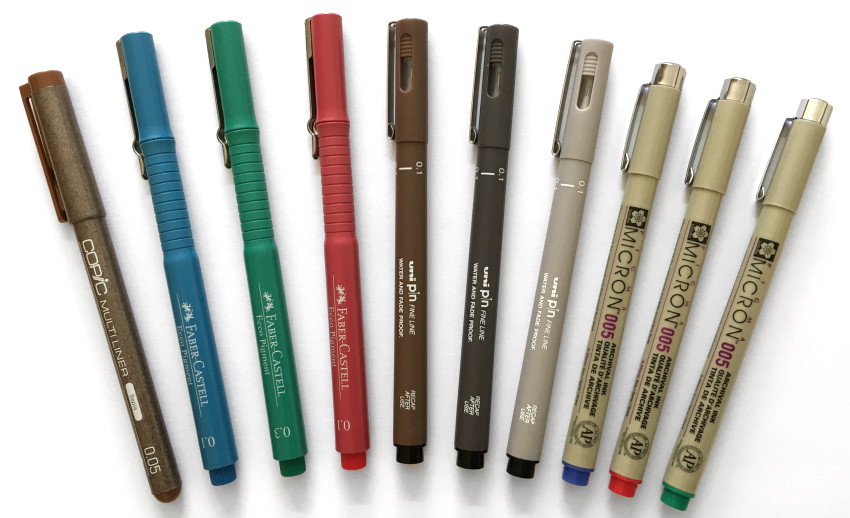 Colored technical pens
Colored technical pens
I prefer black ink, but occasionally I like to mix it up with colors.
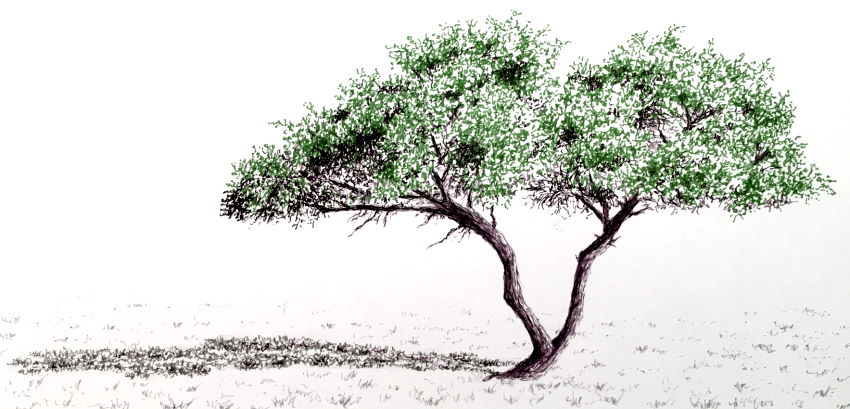 Acacia tree
Acacia tree
Log
To draw logs, timber, or tree trunks, offset by drawing the outlines gently.
Pay attention to foreshortening, and add together some bones details.
Lastly, determine where to identify the lite source, and draw a gradual transition in brightness values with sketchy marks.
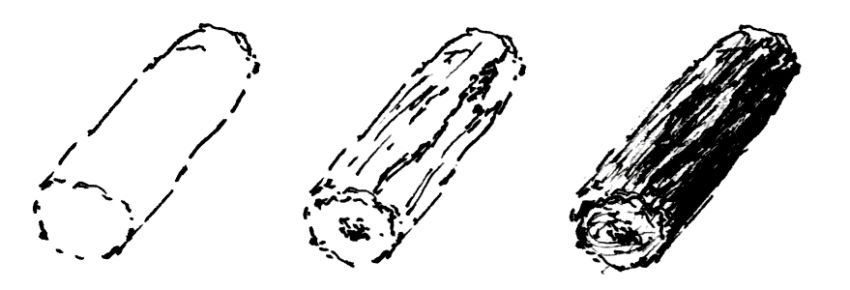
Transitions:
A cylindrical object has a transition in effulgence values, from dark to light.
When using a black pen, draw more than lines for darker areas.
Some other option is to draw less defined lines (swiftly at an angle), and add more lines for darker values.

Colored pens:
Unlike blackness pens, colored pens come in different levels of opacity.
When drawing more than in the same surface area, the pen creates a darkness value. Sometimes you can let the pen ink dry, and then draw over it again.
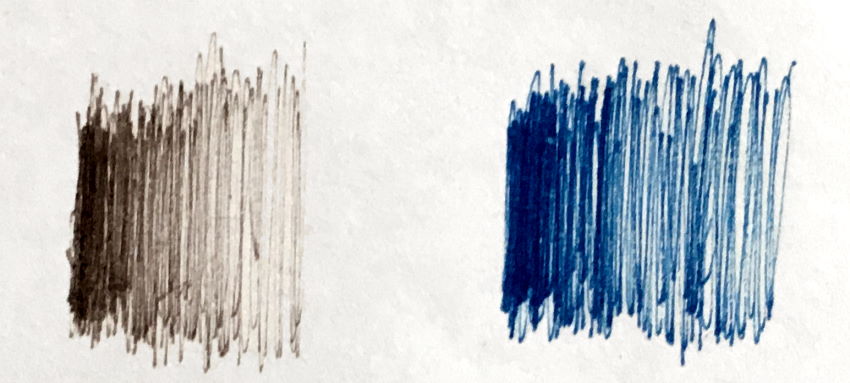
Edges:
Cast shadows unremarkably have soft edges (see below how the bandage shadow from the rope has a soft border).
When yous scribble the wood texture, you lot desire to accept some dents and holes in some areas.
Draw these dents with a hard border on their darker part, and a soft edge when the transition ends (the calorie-free side of the dent, or hole).
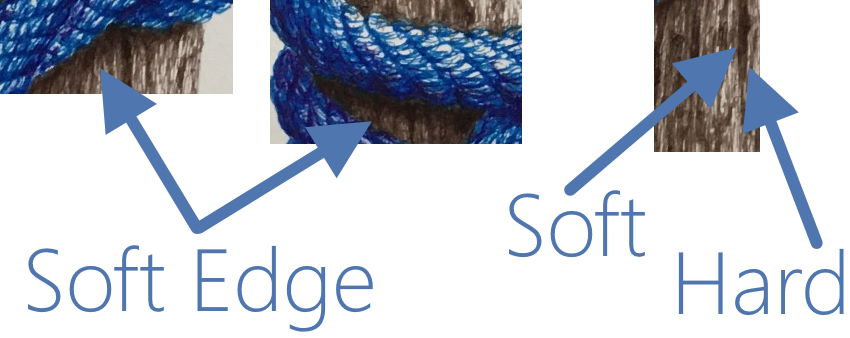
For a more than realistic rendering, with more details, draw large.
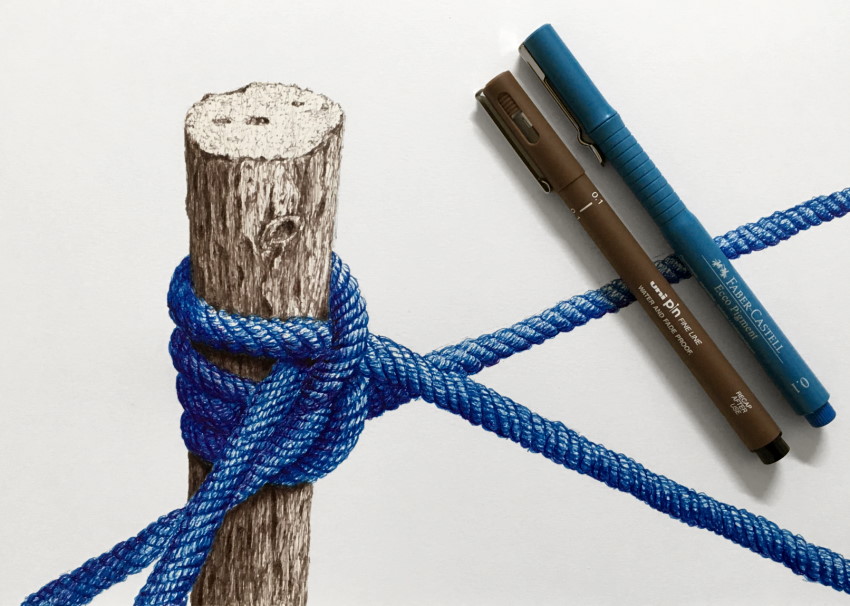
Summary
While in that location are no lines in nature, pens can only create lines!
Drawing is creating an illusion. The globe is three-dimensional, but your paper-sheet is two-dimensional.
To create this illusion, pay attention to effulgence values, edges, and transitions (amongst other things).
A pen has only ane effulgence value, then, unlike other cartoon mediums (graphite, charcoal, pastel...), you have to create the illusion of different brightness values and transitions (in effulgence values).
When drawing trees, focus on accurateness of the form, and on effulgence values.
Brand sure you accept enough contrast between highlights and shadows, for the drawing to be noticeable.
After yous master drawing the form and effulgence values, details (texture) make all the deviation.
If you liked this article, y'all might like my bloom pen-drawing guide too.
For my recommended pens that I used in this guide, visit my review for fineliners and technical pens for drawing.
![]()
![]()
Copyright © RanArtBlog.com. All Rights Reserved. | Sitemap
Source: https://ranartblog.com/blogarticle10.html
Posted by: grahamladmoultan.blogspot.com


0 Response to "How To Draw A Tree Leaves"
Post a Comment